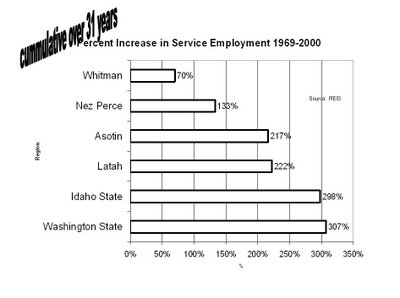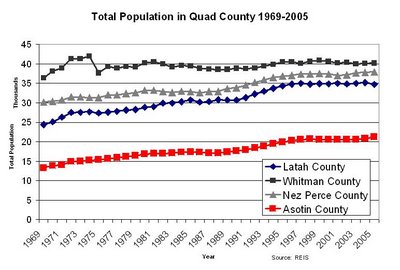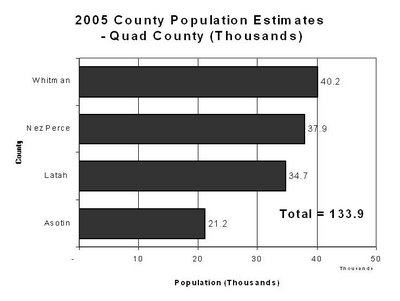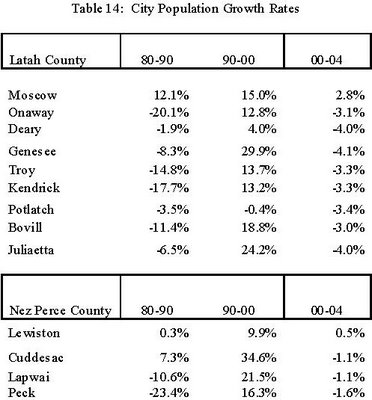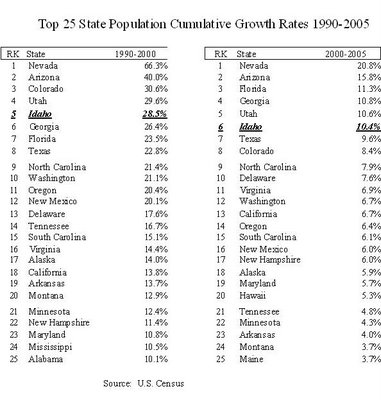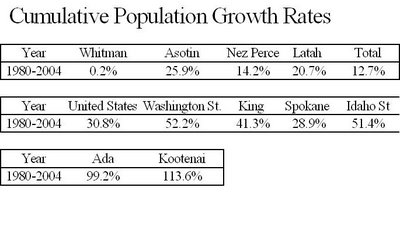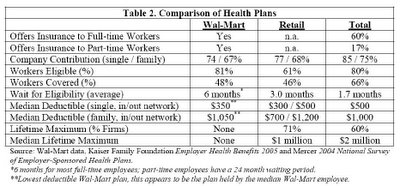During the next 11 days, I am going to be posting each of the 11 myths about Wal-Mart that Dr. Steven Peterson, U of I Research Economist, debunked at the
Moscow Chamber of Commerce luncheon on Wednesday.
Charge 1: Wal-Mart Pays Low wagesFact: Wal-Mart’s U.S. average annual wage of $21,029 is competitive in the retail trade industry..Fact:Regionally, the evidence suggests that Wal-Mart puts moderate upward pressure on retail trade wages in rural (low cost/low wage) regions of the country (i.e. raises retail trade wages). The more urban, higher cost, and unionized the region the more likely Wal-Mart puts moderate downward pressure on retail trade wages. Nationwide, Wal-Mart likely has little overall effect on retail trade wages.
Fact: The supermarket mythContrary to popular belief, nation-wide Wal-Mart ($21,029) pays above average U.S. supermarket salaries ($18,432). Locally the Moscow Wal-Mart average wage ($22,006) is above the local average supermarket wage ($19,040).
Fact:Wal-Mart is above the U.S. average wage for general merchandise/ discount stores of $18,455; and is below (but relatively close) to the overall mean retail wage of $22,495.
Note: the primary wage data in this report was obtained from 2004 County Business Pattern data adjusted for inflation to 2005 dollars.
Fact: Above local retail wagesThe Moscow Wal-Mart approximately 24% greater than the average retail trade wage in Latah County (as measured by County Business Pattern data). The average Moscow Wal-Mart wage is $22,006 or $10.58 per hour and starting wage is $7.50 per hour. The top hourly wage is about $19 per hour (and these wages exclude management salaries!)The average annual Moscow Wal-Mart wage is above the general merchandise store wage in all 50 states; and above the retail trade wage in 26 states.Wal-Mart’s average wages exclude supervisory and managerial employeesThe government average salary data from both County Business Patterns and Quarterly Census of Employment and Wages include supervisory and managerial employees Fact: Dual income familyA dual income Wal-Mart family receives 117% of Latah County’s median household income ($44,012/$37,699). Nationwide, approximately 67 percent of working age couples is now dual income.Moscow Wal-Mart’s average wage ($10.58/hour) is above the City of Moscow’s minimum living wage proposal for City of Moscow workers and contractors at $10.25/hour.Fact: Most workers are full timeApproximately 74% of Wal-Mart’s hourly workers are considered to be full time, considerably above the retail trade industry as a whole, which range about 20%-40% full-time workers.Wal-Mart Job ApplicantsWhen the Wal-Mart in Lewiston, Idaho opened in 1993 there were up to 3,500 applicants for 270 jobs.
Fact: Dual income familyA dual income Wal-Mart family receives 117% of Latah County’s median household income ($44,012/$37,699). Nationwide, approximately 67 percent of working age couples is now dual income.Moscow Wal-Mart’s average wage ($10.58/hour) is above the City of Moscow’s minimum living wage proposal for City of Moscow workers and contractors at $10.25/hour.Fact: Most workers are full timeApproximately 74% of Wal-Mart’s hourly workers are considered to be full time, considerably above the retail trade industry as a whole, which range about 20%-40% full-time workers.Wal-Mart Job ApplicantsWhen the Wal-Mart in Lewiston, Idaho opened in 1993 there were up to 3,500 applicants for 270 jobs.Other examples:
25,000 applications for 325 job openings at a new store Chicago, 1/2006.8,000 applications for 350 Job openings at new store N.J. Store, 6/0611,000 applications for 400 job openings at new store Oakland, California, 8/2006.8,000 applications for 525 jobs opening at new Store Glendale, Arizona, 2004.This seems to be a consistent pattern in the opening of new Wal-Mart stores. It begs the question: If Wal-Mart is such a bad place to work with such low wages, why so many applicants?Most retail trade jobs are transitoryRetail trade employment is a training and transition wage for a substantial number of retail trade workers on their way to other careers. These workers are not the primary “breadwinners”. The presence of these types of employees is either ignored or understated in many anti-Wal-Mart studies.
So…where did all them “low wage” studies come from?First, you start with high cost--high wage --state: California.Second, you select the highest cost--highest wage --region in California: the bay area of San Francisco (or LA).Third, you select the retail firms with highest wages in the bay area of California: The unionized firms.Fourth: You then compare those average wages against Wal-Mart’s average wages.Fifth: You extrapolate these “findings” across the U.S.Other techniques:
Compare Wal-Mart’s average wages to Microsoft or to General Motors (apples to pineapples comparison)Compare Wal-Mart’s average wages to an ambiguous “largest 100 firms” comparison which suggests “selection error”.Fact distortion, misinterpretation, or data omission.[Peterson refers to the infamous 2004 UC Berkeley study by Dube and Jacobs. PARD/UFCW tried to have Dube flown up from Berkeley to testify at the appeal hearings in Pullman back in January, but it didn't work out.]Fact: Unionized workers represent only 12.5% of the U.S. workforceUnionized workers have declined from approximately 35% of the workforce in 1954 to 12.5% today---and it is still declining.Today out of every eight workers, seven are non union.Costco—a different market model: Costco’s 2005 total sales were only 16.4% of Wal-Mart. Costco employs 120,500 employees (world-wide) versus 1.8 million for Wal-Mart (7% of Wal-Mart’s total). Costco has a different customer base than Wal-Mart, serving higher end products to wealthier families. The average household income of Wal-Mart customers is $35,000 versus $85,000 for Costco. Forty-two percent of Costco customers earn over $100,000.
Government imposed wages would likely bankrupt Wal-Mart: Suppose that Wal-Mart decided to raise its average wage to the equivalent of Costco $21,029 to $33,280 (i.e. raise its wage from $10.11 an hour to $16) for its 1.3 million U.S. employees, an increase per employee of $12,251. This would wipe out Wal-Mart’s entire 2005 $11.2 billion net income and create a ($4.73 billion) net loss, in effect bankrupting Wal-Mart.
The CEO Salary Myth: Contrary to popular opinion, the Wal-Mart’s CEO H. Lee Scott, Jr. $10.465 million salary package was modest by industry standards, ranking 136th place in the U.S by Forbes Magazine. The top salary was Richard D Fairbank, CEO of Capital One Financial at $249.42 million. Scores of actors, actresses, talk-show radio hosts, and professional athletics make more money that the CEO of the world’s largest corporation, who ranked 100th place out of 100 top celebrities.
The evidence suggests that Wal-Mart does not increase poverty: Since Wal-Mart’s pay and benefits is comparable to the average salary package in the U.S. retail trade market, it is possible but unlikely that Wal-Mart’s entry into a county or regional market either increases poverty or decreases average retail wages.
Technorati Tags:
wal-mart walmart

